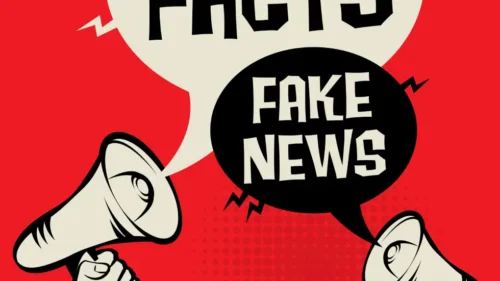On August 11, 2025, the official Department of Homeland Security (DHS) X account posted an image showing Uncle Sam at a crossroads. Signs pointed in various directions read “Cultural Decline,” “Homeland,” “Invasion” and more. Above the photo is a caption, reading “Which way, American man?” While this phrase may not seem overtly sinister, it signals an evolution of political propaganda.
Signaling extremism
The slogan that captioned that photo is a play on the title of American white nationalist and neonazi William Gayley Simpson’s book Which Way, Western Man? Right-wing extremist groups have since adopted this title as a popular meme caption. The phrase has been used to glorify Nazism, criticize feminism and push the white nationalist Great Replacement Theory.
While many people may not be aware of what the DHS account was referencing, it serves as a signal, or dog whistle, to those radical right-wing extremist groups highlighted above. This kind of posting can embolden these groups, as it shows that their ideology has a place in the institutions of the US. The DHS example also highlights the utility of memes as tools of political rhetoric, a reality that could have massive impacts on the political alignment in the US.
Memes as political rhetoric
Memes as features of internet culture existed long before they were prominent tools for political activism. For example, the popular “lolcat” memes or various iterations of Bad Luck Brian are two notable examples of memes from the mid-2010s. While these meme examples are relatively benign, it is important to recognize them as customizable units of information.
Specifically, template and character-based memes, where a certain image and/or character situation is replicated with certain aspects customized to fit a creator’s perspective or motivation, can be a vital and effective tool for political activism. These templates and characters create a shared language that, although overwhelmingly used for harmless comedic purposes, enable a creator to seamlessly transition the purpose of the meme to political extremism.
For example, popular meme templates such as the “Boy and Girl Texting” exist in harmless, mainstream social media discourse. However, an extremist creator can utilize this template as a vessel for extremist political rhetoric, thus making extremist politics more accessible and understandable to a new audience.
Utility to the Trump administration
The second Trump administration has revolutionized online government communications. The previous world of press releases, polished interviews and well-rehearsed statements has now been supplemented by memes, shit posting and viral internet trends. The administration’s posting habits have multiple effects on the public.
First, these posts serve as red meat to rile up the passionate Make America Great Again (MAGA) base. In a political climate so centered on “owning” the opposing side, the second Trump administration is going to previously unseen lengths to placate its base through the internet culture war.
Secondly, these posts aim to desensitize the political opposition. In terms of desensitization, by posting so forwardly about their actions, the Trump administration numbs the public to the inhumanity of what they are doing. This is especially true of the administration’s deportation efforts. When the administration posts so unashamedly about their deportations, the humanity of immigrants becomes lost in the endless sea of internet posts and comments, scrolled past by users as just another fixture of their timeline.
Lastly, and perhaps most importantly, the administration’s posts overwhelm the political opposition and distract from the administration’s destruction of American government foundations. Although it is crucial to recognize memes for their potential as vessels for extremist ideology (i.e., making extremism more accessible to the non-extreme), if this is the primary point of contention with the Trump administration, then the forest is being missed for the trees.
While outwardly memeing about deportations and using AI to make fun of political opponents, the Trump administration has quietly crushed the Consumer Financial Protection Bureau, allowed forever chemicals to remain in drinking water and continually sided with corporations and CEOs over the working class. Not to mention personally enriching the Trump family through a $5 billion cryptocurrency issuance. While these facets of the administration impact the material conditions of Americans far more than their meme warring, these policies are enacted quietly; they often escape the watchful eye of social media.
Opposing the Trump administration can feel like drinking from a firehouse. In the age of social media, the 24-hour news cycle unfolds in front of our eyes every second of the day. With the rise of establishment figures and government organizations engaging in meme wars online, it is important not to lose sight of the quiet actions taken by the Trump administration outlined above. While it is essential to recognize the utility that memes provide the administration, it is just one facet of many that require our resistance in these uncharted times.
The views expressed in this article are the author’s own and do not necessarily reflect Fair Observer’s editorial policy.
Support Fair Observer
We rely on your support for our independence, diversity and quality.
For more than 10 years, Fair Observer has been free, fair and independent. No billionaire owns us, no advertisers control us. We are a reader-supported nonprofit. Unlike many other publications, we keep our content free for readers regardless of where they live or whether they can afford to pay. We have no paywalls and no ads.
In the post-truth era of fake news, echo chambers and filter bubbles, we publish a plurality of perspectives from around the world. Anyone can publish with us, but everyone goes through a rigorous editorial process. So, you get fact-checked, well-reasoned content instead of noise.
We publish 3,000+ voices from 90+ countries. We also conduct education and training programs
on subjects ranging from digital media and journalism to writing and critical thinking. This
doesn’t come cheap. Servers, editors, trainers and web developers cost
money.
Please consider supporting us on a regular basis as a recurring donor or a
sustaining member.
Will you support FO’s journalism?
We rely on your support for our independence, diversity and quality.








Comment